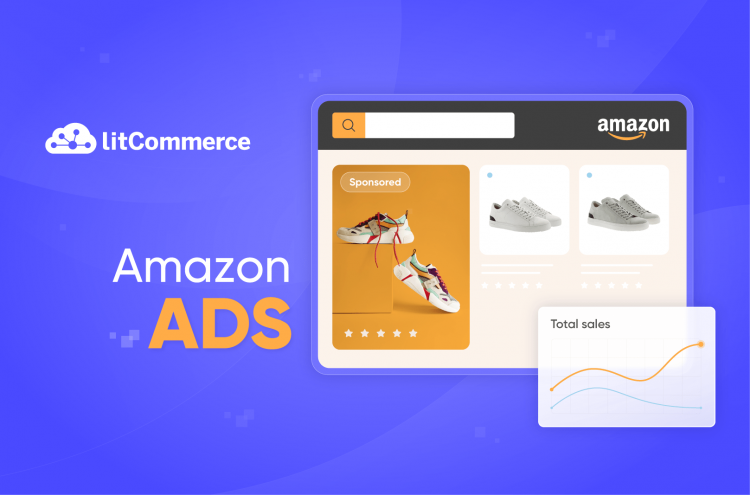Amazon Ads (formerly AMS or Amazon Marketing Services) is a powerful advertising service that allows businesses of all sizes to promote their products directly to customers, which is one of the best ways to increase sales on Amazon. The service offers insightful information so you can create targeted campaigns reaching the right audiences both on and off Amazon.
By getting more eyes on your products, your Amazon stores can potentially get more sales. However, dealing with ads requires strategic approaches, or your ads will be costly and inefficient. Hence, LitCommerce will help you have an overview of Amazon Ads and guide you through the crucial steps to successfully promote on Amazon, as follows:
- What is Amazon Advertising?
- Why Amazon advertising are important?
- What are the types of Amazon ads?
- How much does it cost to advertise on Amazon?
- How do you run advertising on Amazon?
Without gatekeeping. Let’s start!
What Are Amazon Ads?
Amazon Ads is a paid advertising platform that allows sellers to promote their products and brands on Amazon.com. Just like Google search results, Amazon displays “sponsored” listings alongside organic search results. These are pay-per-click (PPC) ads, where sellers pay only when a shopper clicks on their ad, regardless of whether a purchase is made.
When running the Amazon advertising campaigns, you will see key metrics below.
- Clicks: This metric indicates the number of times your ads were clicked. Amazon adjusts your report for invalid clicks (accidental or illegitimate) typically within 3 days.
- Impressions: This shows how many times your ad was displayed to customers on Amazon.
- Spend: This metric reflects the total amount spent per campaign, equating to the total click charges per product ad.
- Sales: This represents the total amount of product sales generated within one week of clicks on your ads.
- Advertising Cost of Sales (ACoS): This metric measures the efficiency of your ads, representing the percentage of ad-generated sales spent on advertising. Calculate ACoS by dividing the total ad spend by the revenue generated from the ads.
- Return On Ad Spend (ROAS): This is another efficiency metric and the inverse of ACoS. Calculate ROAS by dividing the sales attributed to your ads by your ad spend. For example, a ROAS of 5 means that for every $1 spent on ads, you receive $5 in revenue.
Are Amazon Ads Important for your Amazon store?
The answer is definitely Yes. Using Amazon advertising services, you can get more eyes on your products and, more likely, more buyers. Moreover, it also comes with many other advantages. Here are some reasons why you should invest in Amazon advertising:
- New ways to reach shoppers. As there are many types of ad formats, sellers can launch the best one to reach different groups of buyers and then gain better results on the conversion funnel.
- Flexible launching. The flexibility allows businesses to create multiple campaigns that align with their brand and marketing goals in different periods of time.
- Customizable budget. Unlike traditional advertising, which often requires significant financial investments, Amazon advertising can be accessible no matter your budget.
- Real-time insights. With Amazon advertising, sellers can track results, see how their ads perform, and change the campaign to achieve the best performance.
- Increase your listing ranking: Sales history is a very strong ranking factor. If a product sells better, then Amazon will place it higher up in the ranking of search results. Thus, by running advertising for your products, you can boost your product sales, which might improve their organic rankings.
If you sell on Amazon, you can have many options for Amazon advertising services. Take a look at the below section.
Types of Ads on Amazon
Amazon offers a variety of ad formats to suit different needs and budgets. However, Amazon Advertising basically can be divided into two categories below:
- Self-Service Amazon PPC or Pay-per-click ads: PPC ads are typically for professional sellers and brand-registered Amazon sellers. With PPC, you pay Amazon for each customer’s clicks whether they make a purchase or not. Some main kinds of PPC ads include Sponsored Products, Sponsored Brands, and Sponsored Display ads.
- Managed-Service Amazon DSP – Amazon Demand-Side platform: This option is available not only for Amazon sellers but also for advertisers and agencies. However, it requires a large budget of at least $50,000, and you need to contact an Amazon Advertising account to start using Amazon DSP.
So, in this article, I will cover the main Amazon PPC ads that you can start running with our own Amazon Seller Central account.
Sponsored Products Ads
Sponsored Products ads are Amazon’s most common and popular ad type. These ads can appear at the top of the search results page, within organic results, and on competing product listing pages, significantly enhancing your product’s visibility and driving traffic to your product page. Each sponsored product listing is marked with a “Sponsored” tag above it.
Sponsored Products ad is available for every Amazon seller. It doesn’t require brand registration and is the simplest form of PPC to set up.
Here is an example of Sponsored Products on Amazon in the search results.
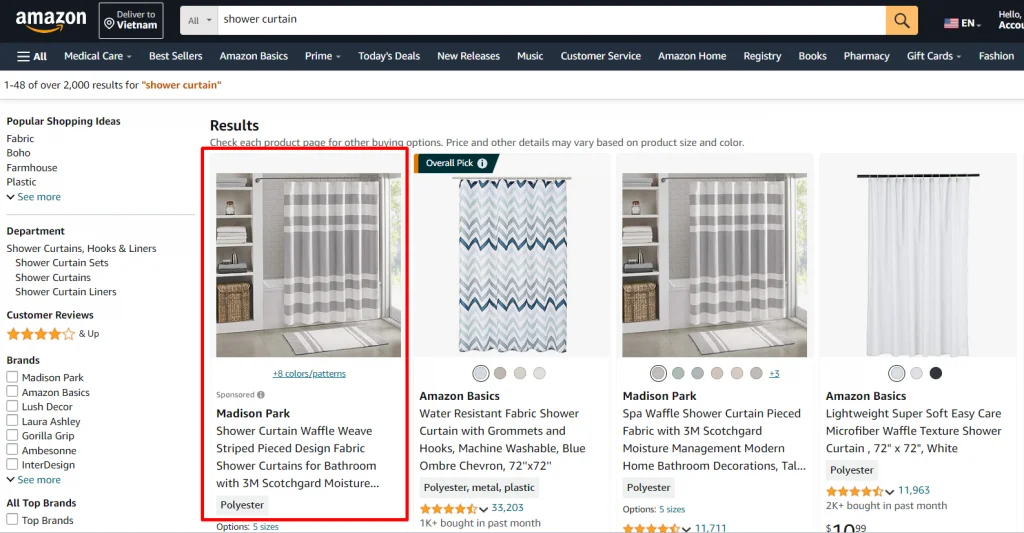
This is how Sponsored Product ads appear on a listing page:
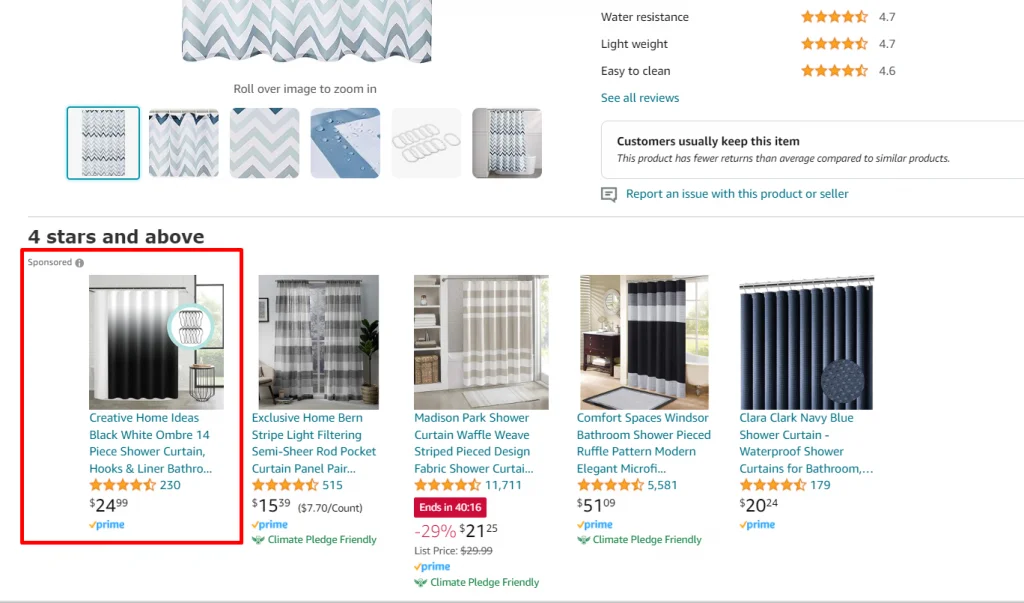
Sponsored Brands Ads
Sponsored Brand ads, previously known as Amazon Headline Search Ads, are a more advanced advertising solution available to sellers enrolled in the Brand Registry program.
On Amazon, Sponsored Brands ads display a banner that features your logo, custom tagline, and thumbnails for a few products. They appear above Sponsored Product ads in Amazon search results.
These custom banner ads allow you to advertise up to three products at a time, giving customers a broader overview of your brand—and thereby increasing brand awareness. Specially, the biggest advantage here is that there are no competitor listings to distract customers from your brand – just your products. These types of ads help drive brand awareness by funneling all traffic to your custom Amazon storefront or a dedicated brand-centric landing page on Amazon.
Here is an example of Sponsored Products on Amazon when I search for “straw tote bag”:
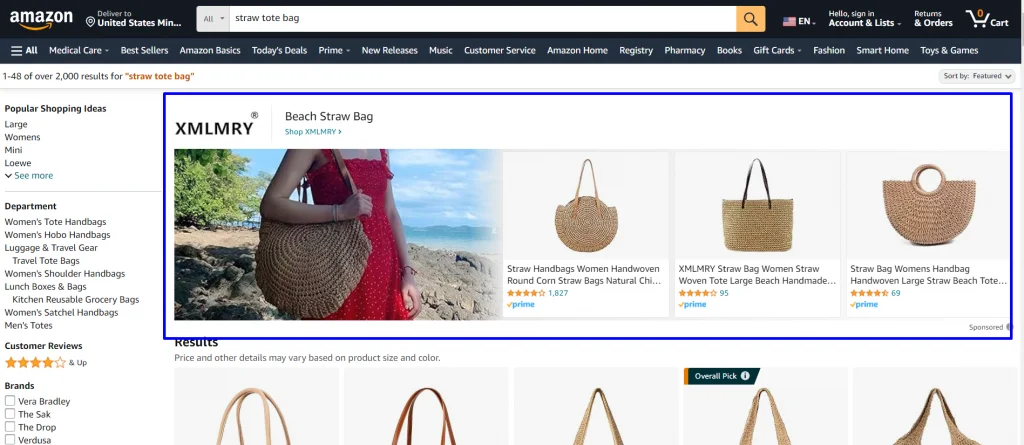
Sponsored Display Ads
Sponsored Display is a new Amazon advertising tool that allows brand-registered sellers and Vendors to reach audiences on and off Amazon, including third-party websites and apps.
Unlike Sponsored Brands or Sponsored Product ads which target customers based on keyword, Sponsored Display targets customers based on interests, shopping behaviors, and past product views. Amazon tracks the products a customer views on its site and re-displays them across Amazon search results, competitor listings, and third-party websites or apps that the customer uses.
Besides the above Amazon ad types, some others that you might care about are:
- Amazon stores: These are the customized storefronts on Amazon that showcase your brand story, products, and curated collections, enhancing your brand presence and driving engagement.
- Audio ads: These ads play on the free tier of Amazon Music across Alexa-enabled devices, including Echo and Fire TV, as well as on mobile and desktop.
- Video ads: Streaming TV commercials occur on linked TVs, publisher channels and networks, IMDb, and IMDb TV. Out-stream video adverts occur on and off Amazon.
Amazon Advertising Cost: How Much You Need To Pay?
Regarding advertising costs, Amazon offers comprehensive pricing plans. Therefore, anyone can create an ad campaign within a small budget. In general, Amazon sellers might pay for ads in several ways, such as:
- Cost-per-click (CPC). This determines how much advertisers pay for the ads based on the number of clicks the ad receives in PPC.
- Cost-per-thousand (CPM). This is the price that 1,000 advertisement impressions on one web page cost.
- Required minimum spend. In this case, sellers must set a minimum spend at a fixed number for the ad;
- Customized cost. Advertisers who want to tailor-make their ads will pay based on their expectations, which are usually not fixed.
According to Amazon Ad types, the cost will vary. Therefore, advertisers can consider the best one for their business.
Firstly, Amazon Sponsored Product ads vs Sponsored Brands, and Sponsored Display are all CPC advertisements, which means you only pay when people click on your ad and have complete control over your campaign budget.
Subsequently, audio advertising is typically sold on a CPM basis. This pricing model allows advertisers to potentially reach a larger audience while keeping their advertising costs in check.
Advertising with an Amazon advertising account executive via a managed-service option (display advertising, video advertisements, and ads run through the Amazon DSP) normally requires a minimum expenditure of $50,000 (USD). Moreover, the final cost of display and video advertising campaigns varies based on the format and where you want to place them.
Customized cost is applied for custom programs, which means the pricing will be determined by the specific requirements of advertisers. This allows businesses to create unique advertising experiences that better align with their marketing goals and target audience.
How to Run An Effective Amazon Ads Campaign?
Launching Amazon Ads is one of the best ways to expand your business and reach more customers. Here are some steps that can help you run the Amazon ads and promote your business effectively:
- Step 1: Defining the goal of Amazon ad campaign;
- Step 2: Enhancing Amazon advertising;
- Step 3: Launching ad on your Amazon store;
- Step 4: Monitoring the results from Amazon ad management system.
Step 1: Define the goals of Amazon advertising
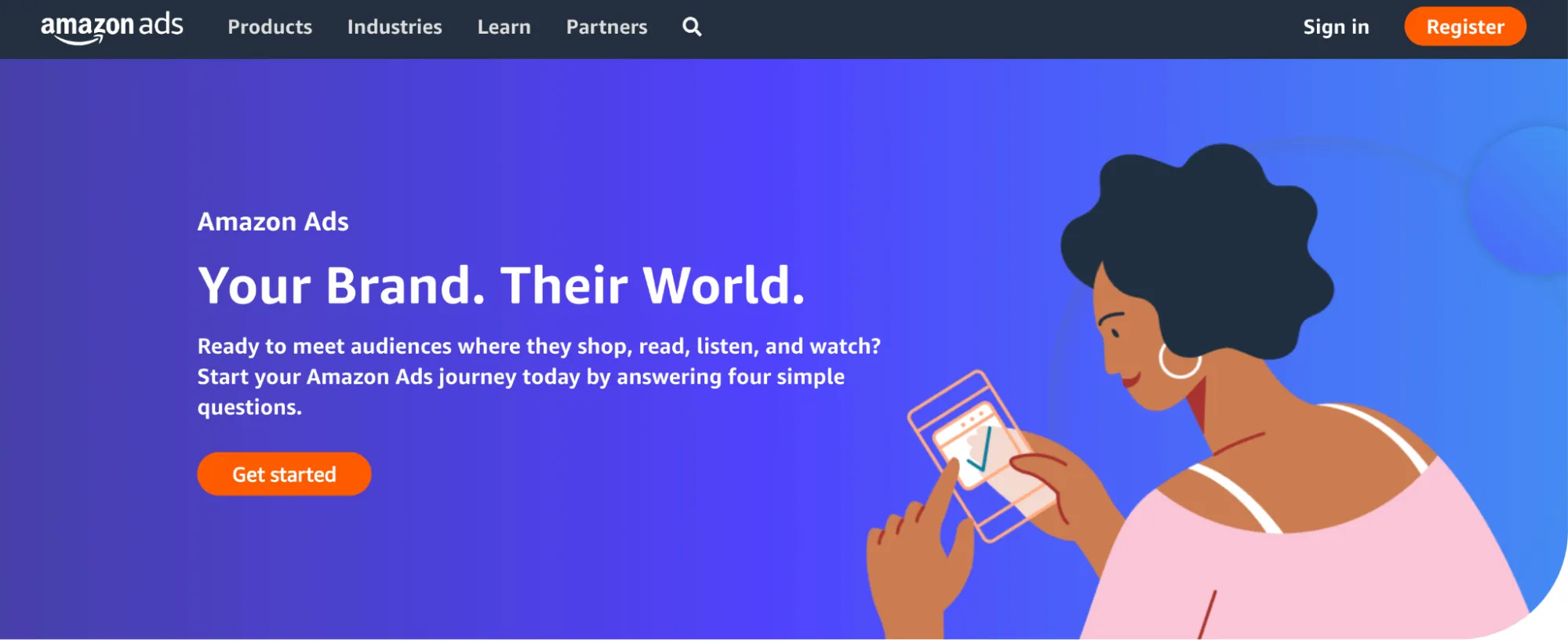
Without defining the goals of Amazon advertising, the campaign may lack direction and focus, leading to inefficient allocation of resources and potentially lower returns on investment.
On the other hand, defining goals before launching might bring many benefits such as:
- Coherent strategies: Advertising objectives play a vital role in the digital marketing effort. In detail, Ads goals create a road map for the marketing team to follow, allowing them to prioritize activities and manage resources efficiently.
- Measurable results: The ad objectives are often measurable, enabling the team to assess the performance of the digital marketing campaign. This helps to make data-driven choices and adapt the digital marketing plan if required.
- Consistent growth: There should not be any conflict between the goals of advertising campaigns and overall business development. This guarantees that the digital marketing strategy contributes to the overall performance and growth of the company rather than operating in isolation.
Moreover, advertising goals should be specific, measurable, and time-bound. Let’s take a look at below table, which might help you to define the goal.
Goal | Objective | Sample metric | |
Awareness |
| Tell your business’s stories, reach out to new consumers, and aid in the development of trust and confidence in your brand. Assist in increasing the size of your target audience. |
|
Consideration |
| Create relevant and compelling advertising to reach customers who are in the shopping mood. Consideration campaigns are designed to engage potential consumers. |
|
Conversion |
| Engage with high-intent consumers who may transition from the contemplation phase to the buy phase. |
|
Loyalty |
| Assist in increasing repeat purchases from clients who have previously bought your goods or services. |
|
Besides using Amazon Ads, finding the best products to sell on Amazon is also important. When you advertise high-demand products, you can easily generate sales and increase the efficiency of your advertising.
Step 2: Optimize Amazon Ads
1. Add a compelling title
A brilliant title may go a long way and can draw the audience’s attention when they see your items. You can follow the below tips to optimize titles for your Amazon Ads and avoid Amazon advertising mistakes:
- Use related keywords: It is recommended to include some priority target keywords with high search volume, preferably long-tail keywords.
- Optimize for mobile devices: Make sure your title is optimized for mobile devices, as most Amazon shoppers use mobile devices to make purchases.
- Avoid keyword stuffing: Do not overuse keywords in your title. It can make your title look spammy and unprofessional.
- Include your brand name: Including your brand name in the title can help build brand recognition and trust among customers.
- Highlight the unique selling point: Mention the unique selling point of your product in the title to attract potential customers and differentiate your product from competitors.
- Use separators for longer titles: If your title is longer, use separators such as hyphens or pipes to make it easier to read and understand.
2. Leverage customer ratings and reviews
Amazon uses reviews to improve customer shopping experience. There are 93% of people depend on these evaluations to assist them in making purchasing decisions on Amazon. These star ratings and reviews may benefit consumers since they help to develop credibility and confidence in your brand’s items.
To have a better chance of selling, use these tips in your Amazon advertising:
- Encourage customers to leave reviews. Consider including a note in your product packaging or following up with customers via email after their purchase to encourage them to leave a review.
- Respond to customer reviews. Regularly check your product listings for new reviews and respond to feedback. This can show customers that you value their opinions and are committed to providing a high-quality product and customer experience. This also helps to remove negative feedback on Amazon, which is crucial for attracting potential customers.
- Use customer reviews in your ad campaigns. Highlight positive customer reviews in your ad content to increase the credibility and appeal of your products. You can also use feedback to inspire new ad campaigns or product improvements.
3. Use high-quality images and videos
High-quality images and videos can help attract potential customers and showcase your products in the best lighting. They can also help establish your brand’s visual identity and build customer trust by clearly representing your products.
According to Amazon guidelines, here are recommended photo and video quality for an Amazon ad campaign:
- Image: A minimum resolution of 1000 pixels on the longest side;
- Video: Video files will be transcoded to reduce their size and look in Amazon’s ad placements. Overall, the video should follow the quality as below.
Video asset requirements | |
Video demensions | 1920 x 1080 px (16:9) recommended |
Frame rate | At least 15 FPS |
Audio | 128 kbps / 44 khz |
Recommended bit rate | 2 MBps |
Preffered codec | Video: H.264, MPEG-2, or MPEG-4; Audio: MP3 or AAC |
File size | less than 500 MB |
Video duration | Desktop & Mobile: up to 3 minutes (15 seconds or less highly recommended). Fire tablet: Up to 15 seconds |
Letterboxing | Videos should not have black bars on any side of the video content |
4. Write clear product descriptions
Product descriptions are important for providing customers with the information they need to make informed purchasing decisions. A clear and detailed product description on Amazon Ads can help customers understand the features and benefits of a product. This information can be product dimensions and specifications and any other relevant details that may influence their purchasing decision.
To write a clear description, follow these tips:
- Create a meaningful and helpful product description that includes key product characteristics and warranty information.
- Include at least five bullet points about customer advantages, product usage, and compatibility.
- Make sure to include critical, descriptive aspects like size, color, and size packs.
5. Stay in stock
Stockouts can have significant drawbacks for businesses, including losing sales, decreased customer satisfaction, and low Amazon ad campaign performance. To avoid stockouts on Amazon, consider implementing the following strategies:
- Forecast demand accurately. Accurate demand forecasting can help you achieve future sales and adjust your inventory levels accordingly. To better know the potential sales during a peak time, you can use historical sales data, market trends, and other relevant data to forecast demand as accurately as possible.
- Maintain safety stock. Safety stock is the extra inventory you keep to protect against unexpected demand spikes or supply chain disruptions. Maintaining a safety stock can help you avoid stockouts and ensure you always have enough inventory to meet customer demand.
- Consider using Amazon’s FBA program. Amazon’s FBA (Fulfillment by Amazon) program allows you to store your inventory in Amazon’s warehouses and have Amazon handle order fulfillment. This can help you avoid stockouts by ensuring that your products are always available on Amazon.
- Use inventory management tools like LitCommerce. LitCommerce – a multichannel listing software – can help you stay on top of your inventory levels, streamline the stock status and prevent stockouts. Moreover, you can easily manage across multiple channels without being nerve-racking.
Easily manage across multichannel
Expand your Amazon business and enroll yourself in the multichannel selling journey to become a 6-figure business. LitCommerce will be your comprehensive companion.
Step 3: Launching ads
Now, it’s time to launch your Amazon Ads. As mentioned, Amazon offers multiple ad forms for sellers to promote their products. Hence, in this guide, we will show you how to advertise on Amazon in the fastest and most common way. Let’s start with Sponsored Products.
- Access Seller Central and log in. If you’re new to selling on Amazon, choose sign in.
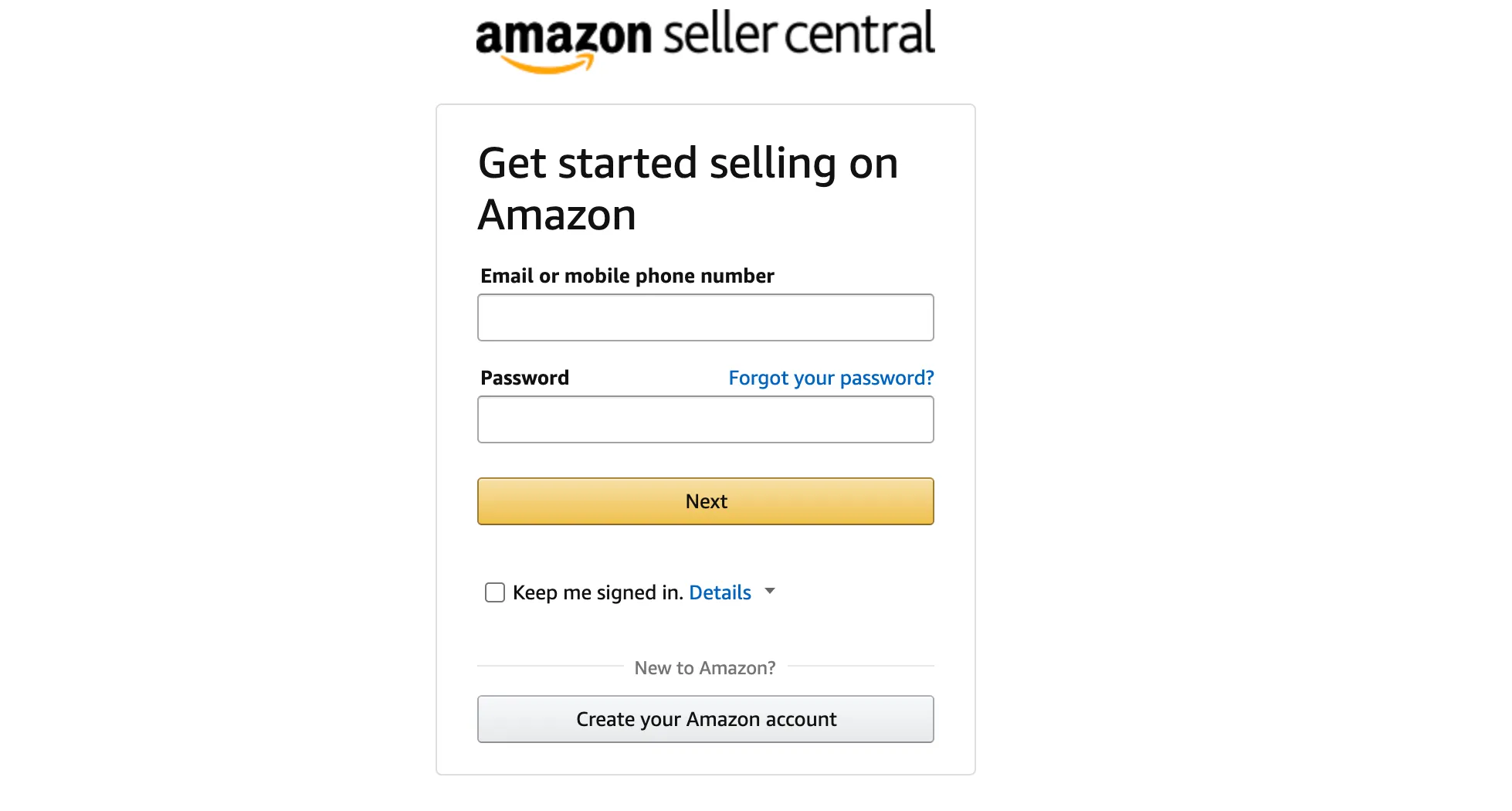
- To begin, click Advertising > Campaign Manager > Create Capaign.
- Select Sponsored Products as your campaign type.
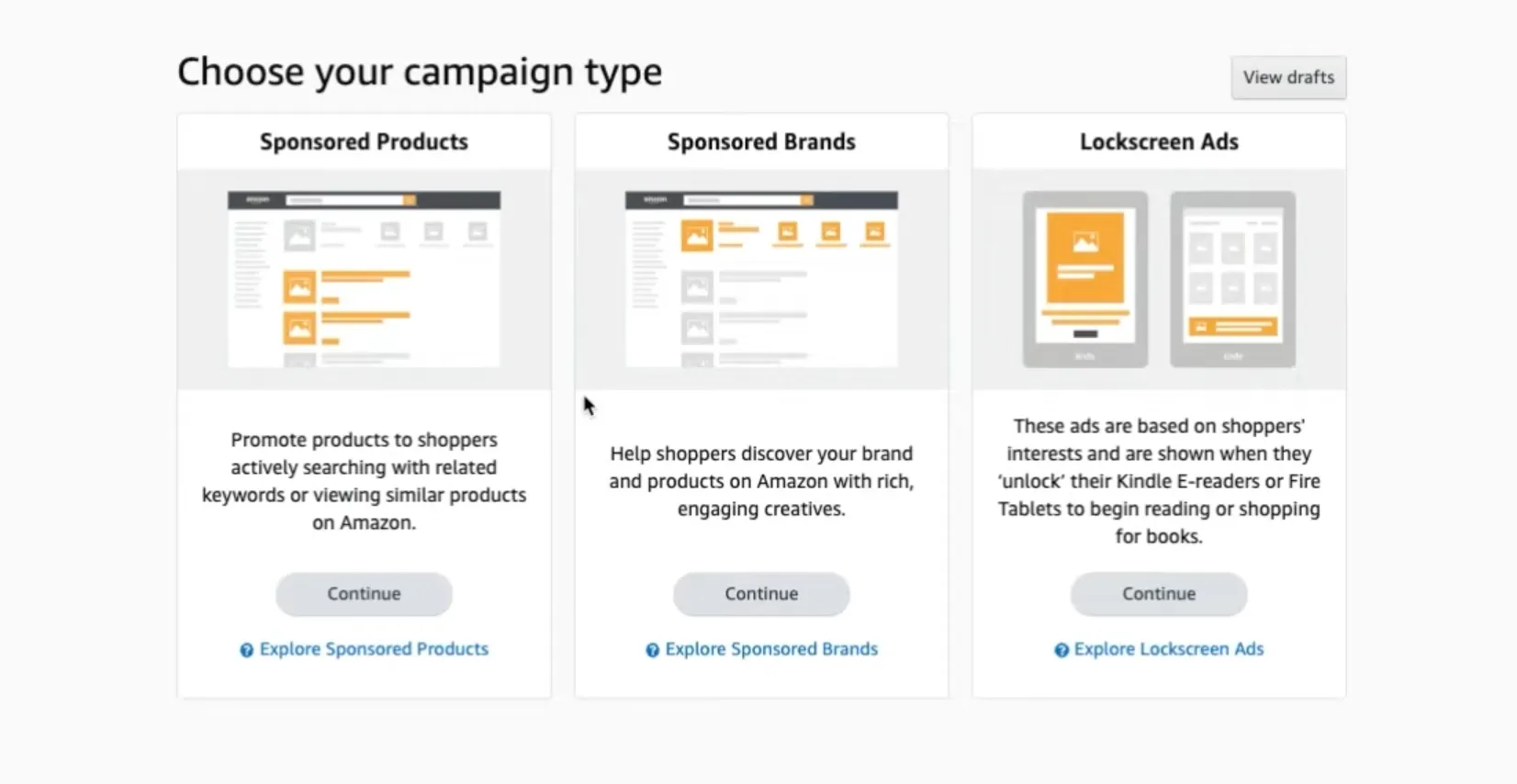
- The system will navigate you to the campaign builder, from here you will need to enter some information such as campaign name, start & end date, daily budget, and targeting.
- Next, you have 3 options to adjust your bidding strategy. As you choose one option, your bid amount will fluctuate or remain fixed.
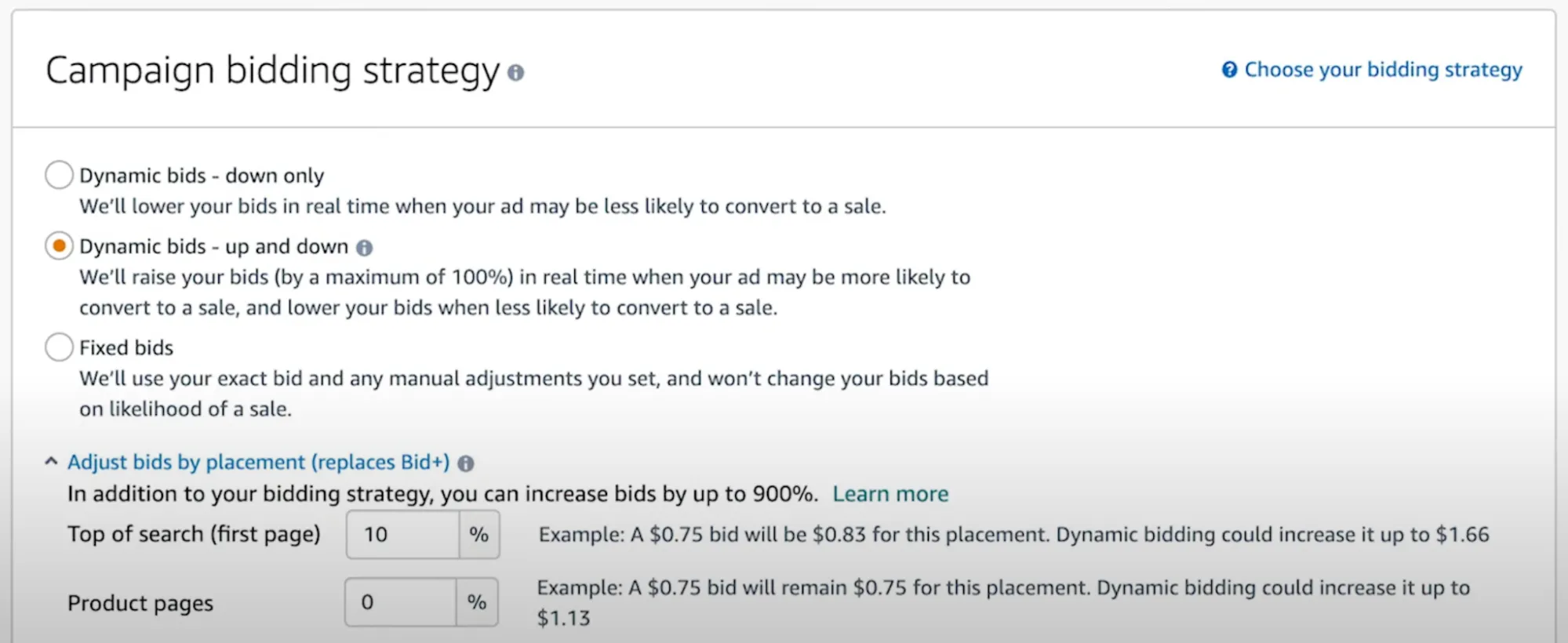
- Next, select products that you want to promote from the list. If you can not see them on the list, you can search by entering the ASIN, product name, or SKU in the search bar.
- Select your default bid, which is the maximum amount you will pay for buyers to click on your ad. You can take a look at Amazon’s suggestion right below to adjust.

- In the next step, you can enter the keyword that you don’t want to show up for.
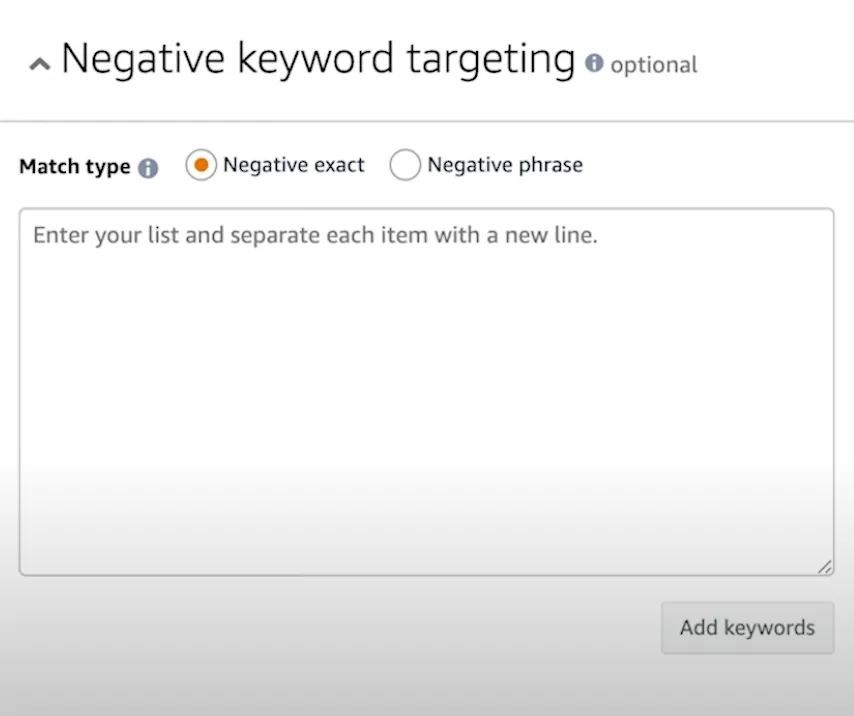
- Once you are done, hit the Launch Campaign button.
Step 4: Monitor the results of campaign ads
Monitoring the results of your Amazon ad campaign is crucial to measure the effectiveness of the campaign. By regularly tracking, you can identify areas where you can optimize your ads and make data-driven decisions to improve your campaign’s performance. Here are some key metrics to track from the Amazon ad system:
- Advertising cost of sales (ACOS): A statistic used to assess the effectiveness of Sponsored Products and Sponsored Brands initiatives. It is determined by dividing ad expenditure by attributable sales.
- Brand lift: This metric is the direct influence of your ads on a shopper’s perception and behavior toward a brand. This measure is calculated in various methods, including utilizing brand recognition and probability of buying.
- Click-through rate (CTR): The proportion of clicked ad impressions compared to the total number of impressions. CTR is often calculated as (clicks/impressions) x 100.
- Conversions: A completed activity by a customer; this term may apply to any activities, such as clicking “Add to Cart,” making a purchase, and so on.
- New-to-brand metrics: These numeric data indicate people who purchased your brand/product for the first time on Amazon in the previous year. These metrics provide marketers with the data they need to assess the cost of acquiring new consumers on Amazon. Hence, they can find the most efficient channels and techniques for achieving campaign objectives.
- Impressions: The number of times an advertisement was shown on a page or device.
- Reach: The total number of people who see the same advertisement on any web page or screen.
- Return on ad spend (ROAS): The amount of money earned for every dollar spent on advertising. ROAS is often calculated as (total ad revenue) / (total ad expenditure).
- Return on investment (ROI): The amount of net profit earned for every dollar spent. The conventional ROI calculation is (revenue – cost) / (cost).
Amazon Advertising Services: FAQs
- Is it worth paying for Amazon ads?
Yes, it is. With Amazon advertising services, you can connect with potential shoppers online, execute, optimize, and track campaigns faster than traditional advertising types. Besides increasing sales, Amazon Ads has many advantages such as:
- New ways to reach shoppers;
- Flexible launching;
- Customizable budget;
- Real-time insights.
- What Amazon ad types are available?
Amazon is a comprehensive marketplace as it offers various ad types. Based on your needs and budget you can choose to implement:
- Amazon Sponsored Products;
- Sponsored Brands;
- Sponsored Display;
- Audio ads;
- Video ads;
- Custom advertising;
- Amazon DSP.
- How to advertise on Amazon?
It is not hard to promote your items on Amazon. However, to utilize the strength of the marketplace and optimize your result. Here are some steps that you should follow:
- Step 1: Defining the goal of Amazon ad campaign;
- Step 2: Enhancing Amazon advertising;
- Step 3: Launching ad on your Amazon store;
- Step 4: Monitoring the results from Amazon ad management system.
Wrapping Up
In short, Amazon Ads can be a powerful tool for businesses of all sizes to promote their products directly to customers. By following the above steps, you can optimize your Amazon ad campaigns and generate greater revenue.
Also, if you want to reach more customers further than Amazon, consider using LitCommerce. Using LitCommerce, you can easily list, sell, and manage stores on multiple channels. Don’t hesitate to drop us a message to start for free.
Moreover, make sure to follow LitCommerce retailer blog to be up-to-date on eCommerce trends, learn more knowledge, insights, sharing, and guides.

